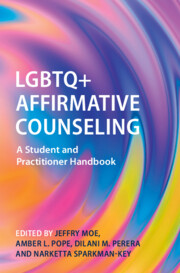Book contents
- LGBTQ+ Affirmative Counseling
- LGBTQ+ Affirmative Counseling
- Copyright page
- Contents
- Figure
- Tables
- Box
- Contributors
- Part I Foundations of LGBTQ+ Affirmative Counseling
- Part II LGBTQ+ Lifespan Development and Family Dynamics
- Part III Assessment and Treatment in LGBTQ+ Affirmative Counseling
- Part IV New Directions in LGBTQ+ Affirmative Counseling
- Index
- References
Part IV - New Directions in LGBTQ+ Affirmative Counseling
Published online by Cambridge University Press: 31 October 2024
- LGBTQ+ Affirmative Counseling
- LGBTQ+ Affirmative Counseling
- Copyright page
- Contents
- Figure
- Tables
- Box
- Contributors
- Part I Foundations of LGBTQ+ Affirmative Counseling
- Part II LGBTQ+ Lifespan Development and Family Dynamics
- Part III Assessment and Treatment in LGBTQ+ Affirmative Counseling
- Part IV New Directions in LGBTQ+ Affirmative Counseling
- Index
- References
- Type
- Chapter
- Information
- LGBTQ+ Affirmative CounselingA Student and Practitioner Handbook, pp. 249 - 308Publisher: Cambridge University PressPrint publication year: 2024

